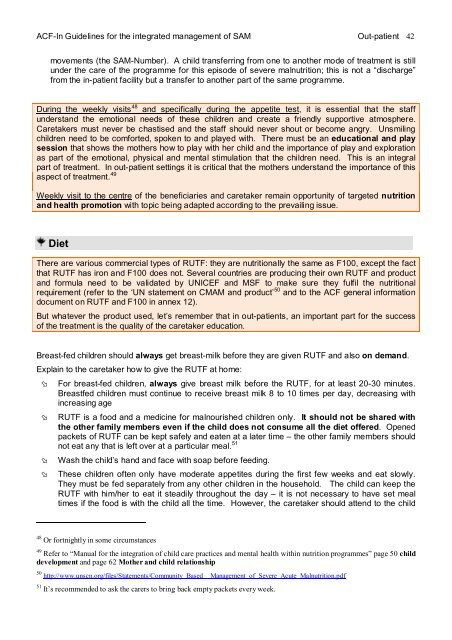guidelines for the integrated management of severe acute malnutrition
guidelines for the integrated management of severe acute malnutrition
guidelines for the integrated management of severe acute malnutrition
Create successful ePaper yourself
Turn your PDF publications into a flip-book with our unique Google optimized e-Paper software.
ACF-In Guidelines <strong>for</strong> <strong>the</strong> <strong>integrated</strong> <strong>management</strong> <strong>of</strong> SAM Out-patient 42<br />
movements (<strong>the</strong> SAM-Number). A child transferring from one to ano<strong>the</strong>r mode <strong>of</strong> treatment is still<br />
under <strong>the</strong> care <strong>of</strong> <strong>the</strong> programme <strong>for</strong> this episode <strong>of</strong> <strong>severe</strong> <strong>malnutrition</strong>; this is not a “discharge”<br />
from <strong>the</strong> in-patient facility but a transfer to ano<strong>the</strong>r part <strong>of</strong> <strong>the</strong> same programme.<br />
During <strong>the</strong> weekly visits 48 and specifically during <strong>the</strong> appetite test, it is essential that <strong>the</strong> staff<br />
understand <strong>the</strong> emotional needs <strong>of</strong> <strong>the</strong>se children and create a friendly supportive atmosphere.<br />
Caretakers must never be chastised and <strong>the</strong> staff should never shout or become angry. Unsmiling<br />
children need to be com<strong>for</strong>ted, spoken to and played with. There must be an educational and play<br />
session that shows <strong>the</strong> mo<strong>the</strong>rs how to play with her child and <strong>the</strong> importance <strong>of</strong> play and exploration<br />
as part <strong>of</strong> <strong>the</strong> emotional, physical and mental stimulation that <strong>the</strong> children need. This is an integral<br />
part <strong>of</strong> treatment. In out-patient settings it is critical that <strong>the</strong> mo<strong>the</strong>rs understand <strong>the</strong> importance <strong>of</strong> this<br />
aspect <strong>of</strong> treatment. 49<br />
Weekly visit to <strong>the</strong> centre <strong>of</strong> <strong>the</strong> beneficiaries and caretaker remain opportunity <strong>of</strong> targeted nutrition<br />
and health promotion with topic being adapted according to <strong>the</strong> prevailing issue.<br />
Diet<br />
There are various commercial types <strong>of</strong> RUTF: <strong>the</strong>y are nutritionally <strong>the</strong> same as F100, except <strong>the</strong> fact<br />
that RUTF has iron and F100 does not. Several countries are producing <strong>the</strong>ir own RUTF and product<br />
and <strong>for</strong>mula need to be validated by UNICEF and MSF to make sure <strong>the</strong>y fulfil <strong>the</strong> nutritional<br />
requirement (refer to <strong>the</strong> ‘UN statement on CMAM and product’ 50 and to <strong>the</strong> ACF general in<strong>for</strong>mation<br />
document on RUTF and F100 in annex 12).<br />
But whatever <strong>the</strong> product used, let’s remember that in out-patients, an important part <strong>for</strong> <strong>the</strong> success<br />
<strong>of</strong> <strong>the</strong> treatment is <strong>the</strong> quality <strong>of</strong> <strong>the</strong> caretaker education.<br />
Breast-fed children should always get breast-milk be<strong>for</strong>e <strong>the</strong>y are given RUTF and also on demand.<br />
Explain to <strong>the</strong> caretaker how to give <strong>the</strong> RUTF at home:<br />
� For breast-fed children, always give breast milk be<strong>for</strong>e <strong>the</strong> RUTF, <strong>for</strong> at least 20-30 minutes.<br />
Breastfed children must continue to receive breast milk 8 to 10 times per day, decreasing with<br />
increasing age<br />
� RUTF is a food and a medicine <strong>for</strong> malnourished children only. It should not be shared with<br />
<strong>the</strong> o<strong>the</strong>r family members even if <strong>the</strong> child does not consume all <strong>the</strong> diet <strong>of</strong>fered. Opened<br />
packets <strong>of</strong> RUTF can be kept safely and eaten at a later time – <strong>the</strong> o<strong>the</strong>r family members should<br />
not eat any that is left over at a particular meal. 51<br />
� Wash <strong>the</strong> child’s hand and face with soap be<strong>for</strong>e feeding.<br />
� These children <strong>of</strong>ten only have moderate appetites during <strong>the</strong> first few weeks and eat slowly.<br />
They must be fed separately from any o<strong>the</strong>r children in <strong>the</strong> household. The child can keep <strong>the</strong><br />
RUTF with him/her to eat it steadily throughout <strong>the</strong> day – it is not necessary to have set meal<br />
times if <strong>the</strong> food is with <strong>the</strong> child all <strong>the</strong> time. However, <strong>the</strong> caretaker should attend to <strong>the</strong> child<br />
48 Or <strong>for</strong>tnightly in some circumstances<br />
49 Refer to “Manual <strong>for</strong> <strong>the</strong> integration <strong>of</strong> child care practices and mental health within nutrition programmes” page 50 child<br />
development and page 62 Mo<strong>the</strong>r and child relationship<br />
50 http://www.unscn.org/files/Statements/Community_Based__Management_<strong>of</strong>_Severe_Acute_Malnutrition.pdf<br />
51 It’s recommended to ask <strong>the</strong> carers to bring back empty packets every week.

















